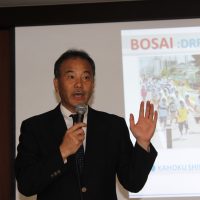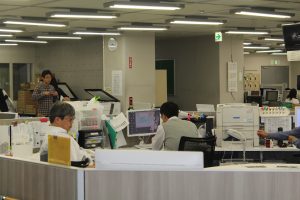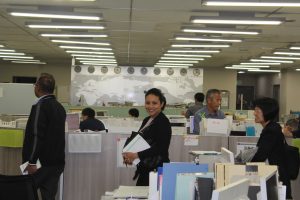
By Monica Miller
Japanese journalist Mr. Shinichi Takeda is a man with a mission that extends beyond journalism
He speaks passionately about the role of the media to prepare people before a disaster, educate and comfort them when disaster strikes and help them rebuild and return their lives to some sense of normalcy after natural calamities.
Mr Takeda led his newspaper’s coverage of the March 11, 2011 earthquake and tsunami that killed an estimated 19,000 in Japan, about half of which were from the prefecture of Miyagi where the Kahoku Shimpo newspaper is based.

Newsroom of The Kahoku Shimpo newspaper
The story this journalist of 38 years shares of how their newspaper managed to print coverage of the disaster the day after the tragedy, is one of dedication and commitment to informing their readers.
The city of Sendai like all of the prefecture of Miyagi lost power, phones were out, and the scene all around was one of mass destruction.
There was no way to find out what was happening in parts of Sendai that were hard hit by the disaster except to send out reporters to the field.
Mr. Takeda said its important in times of tragedy and despair that people be given assurances and hope…be told that things will be alright. He said the media should also prevent confusion after a disaster.
It was from that sense of service to the people that the Kahoku Shimpo delivered 450,000 newspapers to the people of Sendai and other parts of Miyagi prefecture the morning after the most powerful earthquake and tsunami to hit Japan. The evening edition had 70,000 copies.
As Mr, Takeda puts it, there was no power, no gas, no telephones, but there was a newspaper
And the readers showed their appreciation.
“After a few months, we received tons of messages and letters from the readers saying thanks. The letters said that tears overflowed when they held the newspaper, “said Mr. Takeda.”The tears were not the tears of despair it was the tears of hope”.
So how did the newspaper manage to go to print when there was no power, no working computers and no printing press after the tsunami?
It was fortuitous that a month before the disaster, the Kahoku Shimpo signed a contract with another printing company, Niigata Nippou, to print their newspaper in times of emergencies.
Mr Takeda says reporters hand wrote their copy and this was dispatched by car to Niigata Nippou, six hours away. Then the newspaper was printed and delivered to evacuation centers. The newspaper company didn’t charge..that edition, was free of charge.

Journalists from Pacific & Caribbean
After the Great East Japan Earthquake, Mr Takeda was shocked that almost 20,00 people lost their lives. He wondered if his newspaper could have done more to help prevent some of those deaths.
His newspaper conducted a survey of readers in the disaster affected area . One of the questions was “were articles related to the preparations for disasters useful? “ 72% of the people answered no.
Mr. Takeda felt their newspaper had let the people down by not doing enough to educate them about how to prepare for disasters.
Since then he has been at the forefront of disaster preparedness media campaigns in disaster prone areas of Japan and has initiated programs in schools to educate young people of disaster prevention and response. The media campaigns also help preserve memories of the Great East Japan earthquake.
Mr. Takeda doesn’t subscribe to the basic principal of journalism of maintaining independence and impartiality when it comes to the story of disaster preparedness.
He sees it as a social responsibility of his newspaper to help their readers protect themselves from disaster. After all he says, the readership “puts their trust in us”.
News Director Monica Miller is in Japan with a group of journalists from the Caribbean and Pacific, as guests of the Association for Promotion of International Cooperation and the Foreign Press Center Japan.




